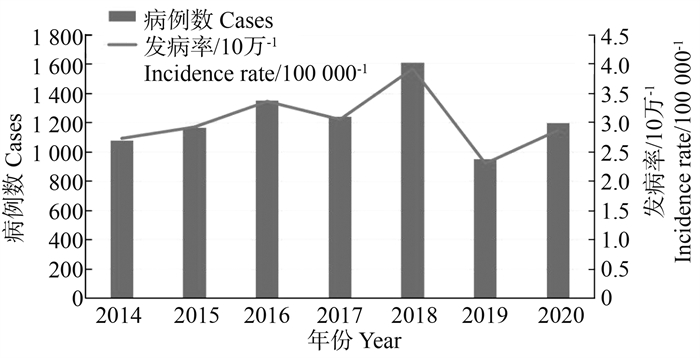Epidemiological characteristics and spatial-temporal clutering of scrub typhus in Fujian Province from 2014 to 2020
-
摘要:
目的 分析福建省2014―2020年恙虫病流行特征和时空聚集性,为制定防控策略提供依据。 方法 收集福建省2014―2020年通过中国疾病预防控制信息系统报告的恙虫病病例信息,采用WPS 2016、SPSS 20.0、ArcGIS 10.0、SaTScan 9.5等软件进行数据处理和统计分析,探索时空分布特征。 结果 2014―2020年福建省共报告恙虫病病例8 595例,年均发病率为3.03/10万,病例主要集中在6―10月,病例集中于40~<70岁(73.10%),职业以农民为主(73.30%)。年均发病率最高的地区是南平市11.71/10万,发病率居前的县区为平和县(36.71/10万)、光泽县(31.28/10万)。时空扫描显示最大可能聚集区多达10个,以平和县为中心覆盖了6个县区。 结论 福建省恙虫病发病存在一定的时空聚集性,应加强对重点人群和重点地区的日常监测和病原检测工作,降低福建省恙虫病发病水平。 Abstract:Objective This study aimed to analyze the epidemiological characteristics and spatial distribution of scrub typhus in Fujian Province from 2014 to 2020, in order to provide evidence for the development of prevention and control measures. Methods The data on scrub typhus were collected through The China Disease Control and Prevention Information System to explore the spatial-temporal distribution characteristics in Fujian Province from 2014 to 2020. We used WPS 2016, SPSS 20.0, ArcGIS 10.0, and SaTScan 9.5 software for data processing and statistical analysis. Results From 2014 to 2020, 8 595 cases of scrub typhus were reported in Fujian, with an average annual incidence rate of 3.03/100 000. The cases were concentrated from June to October. The cases were mainly concentrated in the age group of 40- < 70 years old, accounting for 73.10%. Most patients were farmers, accounting for 73.30%. The highest incidence rate of scrub typhus was 11.71/100 000 in Nanping. The incidence was 36.71/100 000 in Pinghe, and 31.28/100 000 in Guangze, which were higher than in other counties. Temporal scanning showed that there were 10 clustering areas with the highest incidence, with the most significant cluster centered on Pinghe, encompassing six counties. Conclusions A certain characteristic of spatiotemporal clustering is shown in the scrub typhus incidence in Fujian. It is necessary to strengthen routine monitoring and pathogens detection of scrub typhus in the key populations and areas to reduce the incidence of scrub typhus. -
表 1 2014―2020年福建省恙虫病发病数时空扫描
Table 1. Spatio-temporal scanning of scrub typhus cases in Fujian Province from 2014 to 2020
聚集分级
Cluster level聚集时间
Cluster time涉及县区数
Number of county聚集中心
Cluster center半径/km
Radius/km发病例数
Cases期望发病例数
Expected casesRR值
RR valueLLR值
LLR valueP值
P value最大可能
The most possible2015/06/02―2018/11/12 6 平和县
Pinghe County45.15 1 733 314 6.66 1 670.96 < 0.001 2017/05/22―2020/11/01 2 光泽县
Guangze County27.23 452 48 9.83 617.28 < 0.001 2017/05/22―2020/11/01 4 延平区
Yanping District47.12 586 143 4.33 396.28 < 0.001 2017/05/22―2020/11/01 1 松溪县
Songxi County0 180 14 12.96 293.40 < 0.001 2015/06/02―2018/11/12 2 武夷山市
Wuyi Mountain City47.96 226 59 3.88 136.81 < 0.001 2014/06/07―2014/10/04 6 同安区
Tong′an District31.59 127 40 3.24 61.12 < 0.001 2017/05/22―2020/11/01 2 上杭县
Shanghang County32.60 179 71 2.55 58.11 < 0.001 2016/05/27―2018/11/12 3 华安县
Hua′an County47.82 104 49 2.14 23.46 < 0.001 2017/06/21―2017/10/18 1 宁化县
Ninghua County0 20 3 6.80 21.27 < 0.001 2019/06/11―2020/12/31 1 福清市
Fuqing City0 39 13 3.10 17.68 0.001 二级可能
The second possible2016/06/26―2018/10/13 1 永定区
Yongding District0 57 26 2.16 13.29 0.020 2018/05/17―2018/09/13 3 泰宁县
Taining County34.90 18 4 4.46 12.95 0.034 三级可能
The third possible2014/06/07―2014/10/04 1 连江县
Lianjiang County0 21 6 3.52 11.37 0.115 2020/12/02―2020/12/31 1 福安市
Fu′an City0 9 2 6.01 8.64 0.715 -
[1] 何似, 谢忠杭, 陈阳, 等. 福建省2006-2009年恙虫病流行特征分析[J]. 中华疾病控制杂志, 2011, 15(2): 123-125. http://zhjbkz.ahmu.edu.cn/article/id/JBKZ201102011He S, Xie ZH, Chen Y, et al. Epidemiological characteristics of scrub typhus from 2006 to 2009 in Fujian Province[J]. Chin J Dis Control Prev, 2011, 15(2): 123-125. http://zhjbkz.ahmu.edu.cn/article/id/JBKZ201102011 [2] 韩腾伟, 刘菁, 洪荣涛, 等. 福建省2010-2013年恙虫病流行特征分析[J]. 海峡预防医学杂志, 2015, 21(6): 8-10. https://www.cnki.com.cn/Article/CJFDTOTAL-HXYF201506005.htmHan TW, Liu J, Hong RT, et al. Epidemiological characteristics of tsutsugamushi disease in Fujian, China (2010-2013)[J]. Strait J Prev Med, 2015, 21(6): 8-10. https://www.cnki.com.cn/Article/CJFDTOTAL-HXYF201506005.htm [3] Kwak J, Kim S, Kim G, et al. Scrub typhus incidence modeling with meteorological factors in South Korea[J]. Int J Environ Res Public Health, 2015, 12(7): 7254-7273. DOI: 10.3390/ijerph120707254. [4] Wu YC, Qian Q, Soares Magalhaes RJ, et al. Spatiotemporal dynamics of scrub typhus transmission in mainland China, 2006-2014[J]. PLoS Negl Trop Dis, 2016, 10(8): e0004875. DOI: 10.1371/journal.pntd.0004875. [5] 周淑姮, 韩腾伟, 王加熊, 等. 福建省部分地区野栖鼠体表寄生恙螨的物种多样性调查[J]. 中国人兽共患病学报, 2021, 37(6): 511-519. DOI: 10.3969/j.issn.1002-2694.2021.00.076.Zhou SH, Han TW, Wang JX, et al. Investigation of chigger mite species diversity parasitizing wild rodents in some areas of Fujian Province[J]. Chinese Journal of Zoonoses, 2021, 37(6): 511-519. DOI: 10.3969/j.issn.1002-2694.2021.00.076. [6] 王玉姣, 闫冬明, 李贵昌, 等. 北京市平谷区2008-2018年恙虫病流行特征分析[J]. 中国媒介生物学及控制杂志, 2019, 30(3): 244-247. DOI: 10.11853/j.issn.1003.8280.2019.03.003.Wang YJ, Yan DM, Li GC, et al. Epidemiological characteristics of scrub typhus in Pinggu District of Beijing, China, in 2008-2018[J]. Chin J Vector Biol Control, 2019, 30(3): 244-247. DOI: 10.11853/j.issn.1003.8280.2019.03.003. [7] 朱芳, 费媛媛, 姬会春, 等. 宿迁地区132例恙虫病临床特点分析[J]. 热带医学杂志, 2021, 21(4): 460-463. DOI: 10.3969/j.issn.1672-3619.2021.04.015.Zhu F, Fei YY, Ji HC, et al. Clinical features of 132 cases of tsutsugamushi disease in Suqian area[J]. Journal of Tropical Medicine, 2021, 21(4): 460-463. DOI: 10.3969/j.issn.1672-3619.2021.04.015. [8] Yue Y, Ren D, Liu X, et al. Spatio-temporal patterns of scrub typhus in mainland China, 2006-2017[J]. PLoS Negl Trop Dis, 2019, 13(12): e0007916. DOI: 10.1371/journal.pntd.0007916. [9] Li ZJ, Xin HL, Sun JL, et al. Epidemiologic changes of scrub typhus in China, 1952-2016[J]. Emerg Infect Dis, 2020, 26(6): 1091-1101. DOI: 10.3201/eid2606.191168. [10] 李文, 马德龙, 赵嘉欣, 等. 广东省恙虫病流行特征及发病风险预测[J]. 中国媒介生物学及控制杂志, 2021, 32(3): 334-338. DOI: 10.11853/j.issn.1003.8280.2021.03.015.Li W, Ma DL, Zhao JX, et al. Epidemiological characteristics and risk prediction of scrub typhus in Guangdong Province, China[J]. Chin J Vector Biol Control, 2021, 32(3): 334-338. DOI: 10.11853/j.issn.1003.8280.2021.03.015. [11] Yang S, Liu X, Gao Y, et al. Spatiotemporal dynamics of scrub typhus in Jiangxi Province, China, from 2006 to 2018[J]. Int J Environ Res Public Health, 2021, 18(9): 4599. DOI: 10.3390/ijerph18094599. [12] Luo L, Guo ZN, Lei Z, et al. Epidemiology of tsutsugamushi disease and its relationship with meteorological factors in Xiamen City, China[J]. PLoS Neg1 Trop Dis, 2020, 14(10): e0008772. DOI: 10.1371/journal.pntd.0008772. [13] 展海燕, 徐贞, 何义林. 江苏省靖江市2011-2015年恙虫病流行特征及影响因素[J]. 中华疾病控制杂志, 2017, 21(11): 1119-1122. DOI: 10.16462/j.cnki.zhjbkz.2017.11.010.Zhan HY, Xu Z, He YL. Epidemiological characteristics and influencing factors of scrub typhus in Jingjiang City of Jiangsu Province from 2011 to 2015[J]. Chin J Dis Control Prev, 2017, 21(11): 1119-1122. DOI: 10.16462/j.cnki.zhjbkz.2017.11.010. [14] 魏跃红, 李晓宁, 吴新伟, 等. 广州市恙虫病危险因素的病例对照研究[J]. 中华疾病控制杂志, 2017, 21(2): 171-174. DOI: 10.16462/j.cnki.zhjbkz.2017.02.016.Wei YH, Li XN, Wu XW, et al. A case-control study of risk factors associated with scrub typhus in Guangzhou[J]. Chin J Dis Control Prev, 2017, 21(2): 171-174. DOI: 10.16462/j.cnki.zhjbkz.2017.02.016. -





 下载:
下载:





